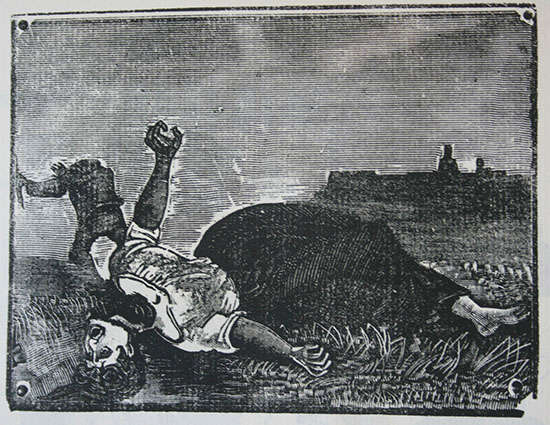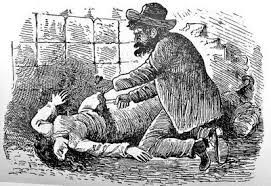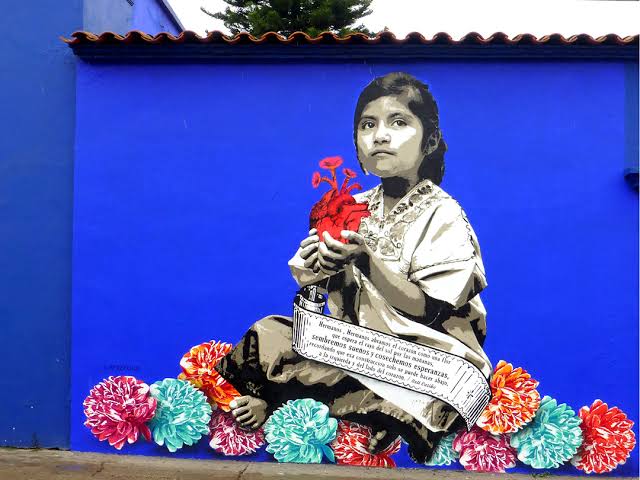
Por Eli Bartra y Liliana Elvira Moctezuma.
PRESENTACIÓN
En esta bien funesta época que estamos viviendo se habla de LA pandemia todo el tiempo. Pero es necesario pensar que hay más de una: en México la pandemia del feminicidio crece cada día. Desde luego que llamarlo pandemia es un tanto metafórico pues el concepto mismo significa que ataca a todo el pueblo, en un plano global, y no como en este caso, que solo afecta a las mujeres.
Un fenómeno similar sucede cuando se habla del holocausto. Genocidios, holocaustos ha habido muchos, por docenas a lo largo de la historia y en todo el mundo: no existe solamente el de los judíos por los nazis. Se dieron las invasiones mongolas en el siglo XIII, que dejaron unos 11 millones de muertos; las conquistas musulmanas en India en el siglo XV produjeron 400 millones de muertos y se le ha denominado el mayor genocidio existente; es decir, la India sufrió genocidios, holocaustos, por parte de árabes, turcos, mongoles, entre otros, durante 800 años. A finales del siglo XIX, en el Congo, el colonialismo belga exterminó a 10 millones de personas. A principios del siglo XX tenemos el holocausto del pueblo armenio por parte de Turquía en el que murieron unos 2 millones de personas. Y no hay que olvidar el holocausto soviético estalinista (1924-1953) contra el pueblo ucraniano, y demás purgas y atrocidades, que cobró unos 5 millones de vidas.
El feminicidio no es un fenómeno nuevo. Lo que sí es relativamente nuevo es el concepto y las proporciones. El de las mujeres violentadas tampoco lo es, quizá son tan antiguos como la humanidad misma.
A pesar de que la violencia hacia las mujeres ha existido a lo largo de mucho tiempo en México, ha sido prácticamente invisible e incluso naturalizada. Además, las mujeres llevan aproximadamente 100 años con acceso a la educación y a la creación artística, por lo que difícilmente los hombres lo iban a hacer visible, a menos que fuera para plasmar algunos hechos específicos, como lo hizo José Guadalupe Posada. Empieza a expresarse después de la Revolución Mexicana con una influencia clara del grabador, como en los casos de Isabel Villaseñor y Frida Kahlo.
Como podrán ver en los ejemplos que hemos seleccionado de prácticas artísticas del México contemporáneo, la imagen de la violencia contra las mujeres ha estado presente a partir de esa época, en unas expresiones más y en otras menos.
Sin afán de comparar, mostraremos obras tanto de hombres como de mujeres, que hemos considerado significativas por su poder estético, con el fin de dar luz sobre sus diferencias genéricas.
Una de las principales representaciones de violencia hacia las mujeres en el arte es, sin duda, el feminicidio. Esto es así seguramente por brutal, por extremo… los golpes, con frecuencia, tienen solución, la muerte, no, el feminicidio, tampoco. El arte que plasma o denuncia el problema de la violencia hacia las mujeres tiene la intención de provocar incomodidad y, algunas veces, empatía. Incomodidad cuando se muestran explícitamente escenas de violencia o elementos que nos remiten a las mujeres maltratadas o incluso asesinadas. Empatía, cuando nos recuerda a algunas que ya no están debido a situaciones de violencia.
Puesto que el arte popular tiende a realizarse para un mercado muy particular, si se plasmaran situaciones de violencia quizá sería más complicado comercializarlo. Muchas veces el arte popular tiende a presentar temas repetitivos en donde este tipo de hechos violentos y su denuncia tienen poca cabida. Sin embargo, es probable que si las artistas populares tuvieran más libertad creativa, podría ser entonces un tema recurrente dado que, lamentablemente, el hecho de ser mujer en México implica, casi necesariamente, haber sufrido algún tipo de violencia: sexual, simbólica, laboral y aquella derivada del crimen organizado.
Las prácticas artísticas influyen considerablemente en las mentalidades, en la conciencia de las personas. Los efectos han sido nocivos, pero también pueden ser muy poderosos y útiles como denuncia, como impugnación. Por eso se ha usado el arte para comunicar ideas políticas de todo tipo. Por ejemplo, el desnudo femenino contribuye a la cosificación de las mujeres, pero también se utiliza para hacer una crítica de su uso subyugante. El feminismo da paso a la aparición de obras que denuncian la violencia hacia las mujeres en todas sus formas. Ha sido absolutamente crucial, por eso hoy en día hay mucho artivismo feminista.Son prácticas artísticas fundamentalmente políticas de impugnación.
ARTES PLÁSTICAS
José Guadalupe Posada (1851-1913).
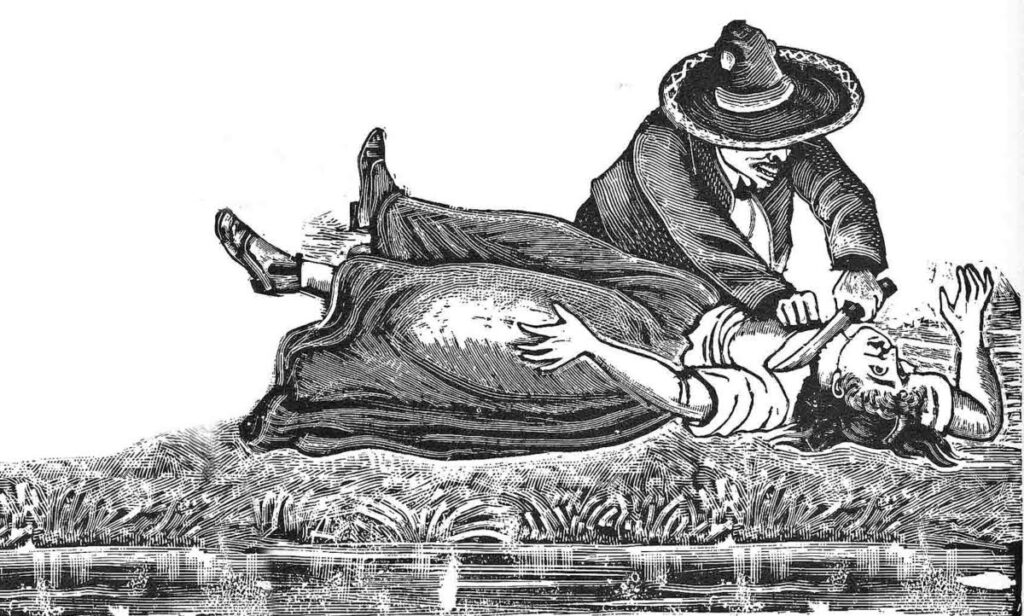
Francisco Guerrero, apodado El Chalequero, fue un asesino serial de por lo menos 20 mujeres durante el Porfiriato. Posada realizó varios grabados sobre sus crímenes, y fue unas de las primeras representaciones que encontramos sobre el asesinato de mujeres y que al parecer sirvieron de inspiración para algunas artistas posteriores.
Isabel Villaseñor (1907-1954)
“Le decía Jesús Cadenas:
A esa güera yo la mando
Les daré satisfacción
No se anden equivocando”
Fragmento
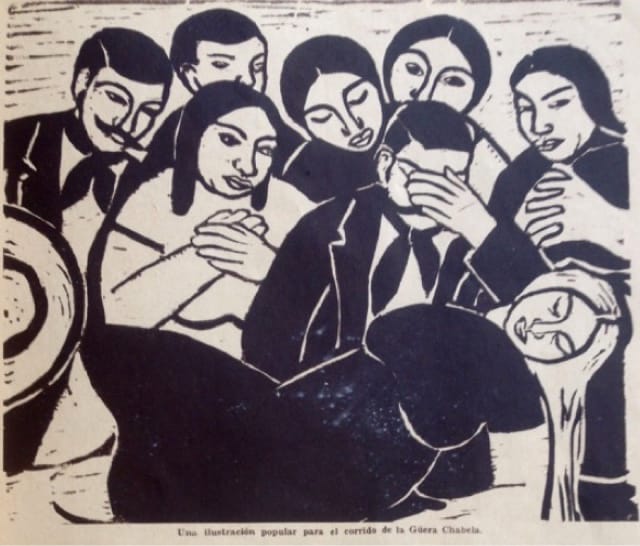
Es una de las primeras representantes del feminicidio en el arte de las artistas mexicanas. En su grabado La muerte de la Güera Chabela de 1929, Isabel Villaseñor ilustra un corrido escrito por Concha Michel. En él se relata el asesinato de la Güera Chabela a manos de Jesús Cadenas, quien la encuentra bailando en un fandango con otros hombres y le da cuatro balazos en el corazón por “mancornadora”. Villaseñor retrata a la familia de la Güera Chabela mientras su padre, su madre y otros asistentes a la fiesta le lloran.
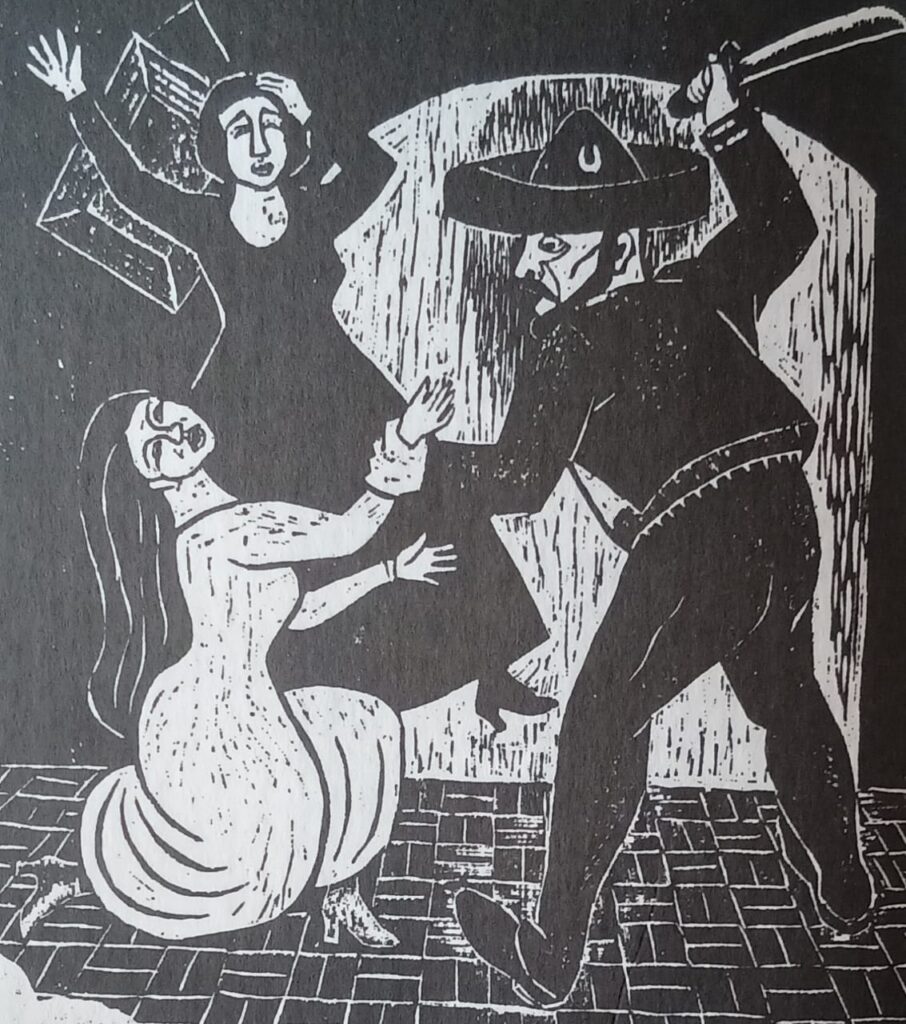
En esta obra sin título, pero que también ha sido llamada “Elena la traicionera”, Isabel Villaseñor recurre nuevamente a ilustrar un corrido, esta vez de su autoría. Para representar la situación de las mujeres, la autora recurrió al género del corrido; escribió la letra, una pieza teatral y este grabado. En el corrido Habla Elena, una joven de los Altos de Jalisco en 1870, es cortejada por Don Fernando, un militar francés. Cuando su esposo se entera, los mata en distintos hechos. En la imagen podemos ver a Elena justo antes de que su pareja la asesine con un machete, mientras que la trabajadora del hogar mira la escena con horror. Isabel Villaseñor en su obra buscó representar muchas situaciones cotidianas de las mujeres: la maternidad, los cuidados, la autorrepresentación y, en estos casos, la violencia. Al denunciarla tanto en su música como en su obra gráfica, apela a la libertad de las mujeres sobre su vida y su cuerpo.
Frida Kahlo (1907-1954)
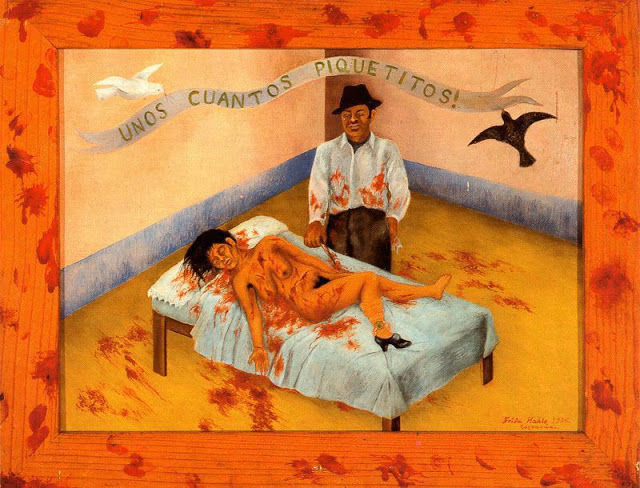
La artista parece ser que leyó en el periódico que un hombre había matado a su mujer y en los tribunales se defendió diciendo que sólo le había dado “unos cuantos piquetitos”. Según la policía, fueron veinte puñaladas. No hay duda que Kahlo fue sensible ante este feminicidio y de ahí la crudeza y crueldad con la que lo representa, donde la imagen va más allá del lienzo y llega al cuadro.
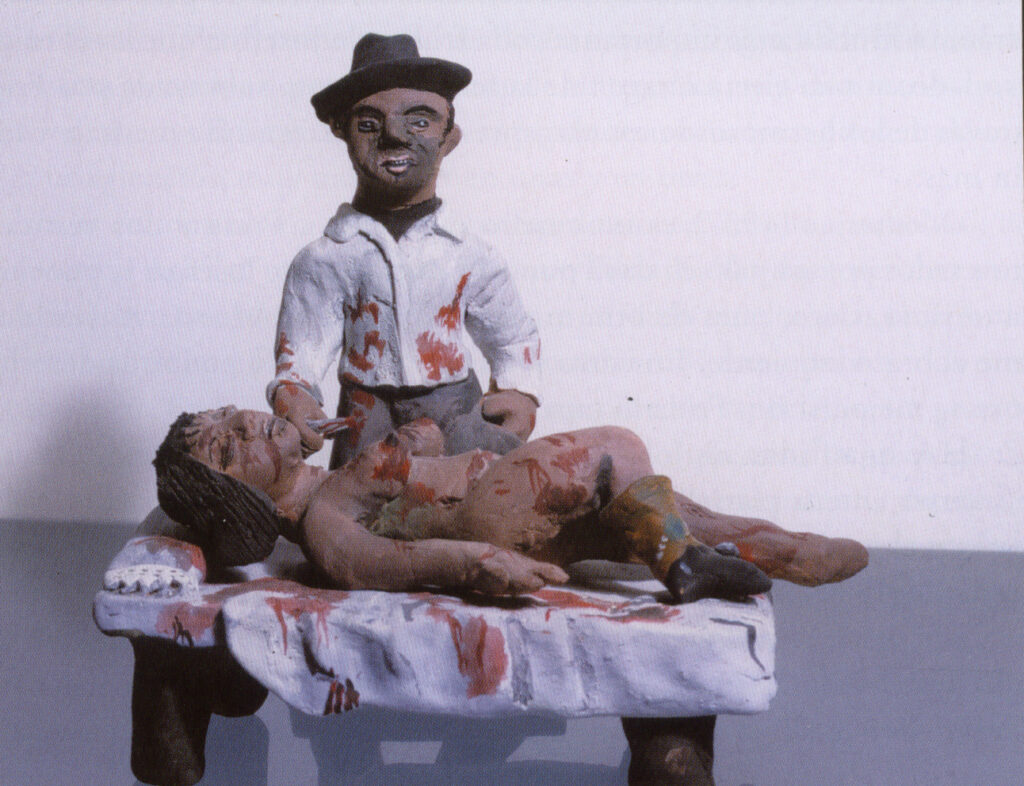
La familia Aguilar, de Ocotlán, Oaxaca, ha recurrido numerosas veces a la representación de Frida Kahlo, pero pocas veces lo hace con algunas de las obras más crudas, como es el caso de Unos cuantos piquetitos. En esta obra de Demetrio García Aguilar, se reproduce la imagen tal cual: las puñaladas, el rostro del asesino, la sangre y el único zapato del que no se despoja a la víctima.
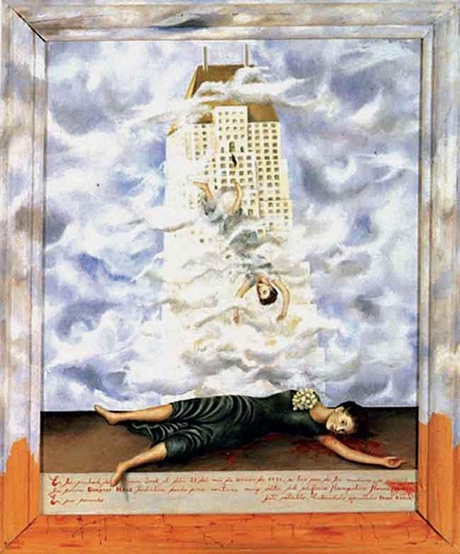
“En la ciudad de Nueva York el dia 21 del més Octubre de 1938, a las seis de la mañana, se suicidó la señora Dorothy Hale tirándose desde una ventana muy álta del edificio Hampshire House. En su recuerdo [….] éste retablo habiendolo ejecutado Frida Kahlo. (sic)”
Frida Kahlo lo pintó cuando estaba separada de Diego Rivera y, al parecer, ella misma tenía pensamientos suicidas. Se ha dicho que puede ser un comentario visual sobre la desesperación de las mujeres cuando un hombre las abandona. Dorothy Hale fue una aspirante a actriz quien, al ver que no había logrado lo que quería, se lanzó desde su departamento en Nueva York. Se dice que le encargaron un retrato póstumo a Frida Kahlo, quien representó el momento justo de su suicidio.
María Izquierdo (1907-1954)
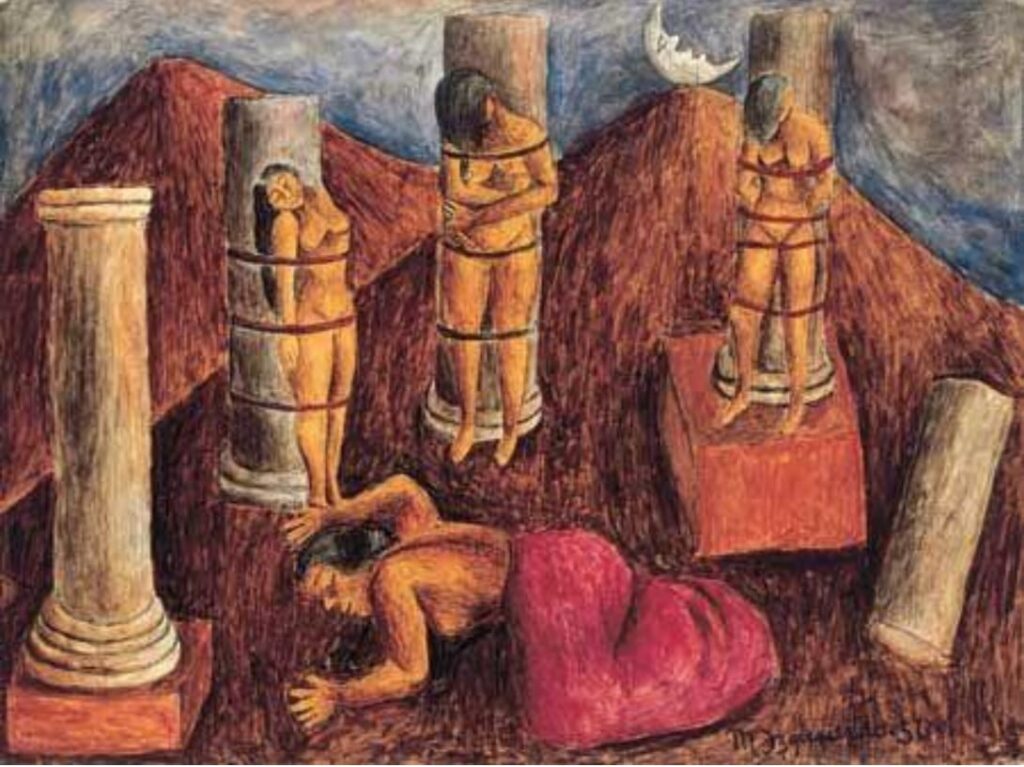
Se ha dicho que esta obra representa la presión de las mujeres en el patriarcado, en específico del amor romántico. Tres mujeres desnudas, atadas a columnas clásicas como representación fálica en medio de unas montañas sin vegetación, sin vida, como el resto de la obra metafísica de Izquierdo. Una mujer yace en el suelo con el torso desnudo inerte y su falda se pliega formando un corazón rosa; atrás de ella se encuentra una columna rota. María Izquierdo, como muchas de las artistas de la época, sufrió la violencia machista de muchas formas al ser excluida de espacios de creación e incluso estigmatizada por ser artista y divorciada.
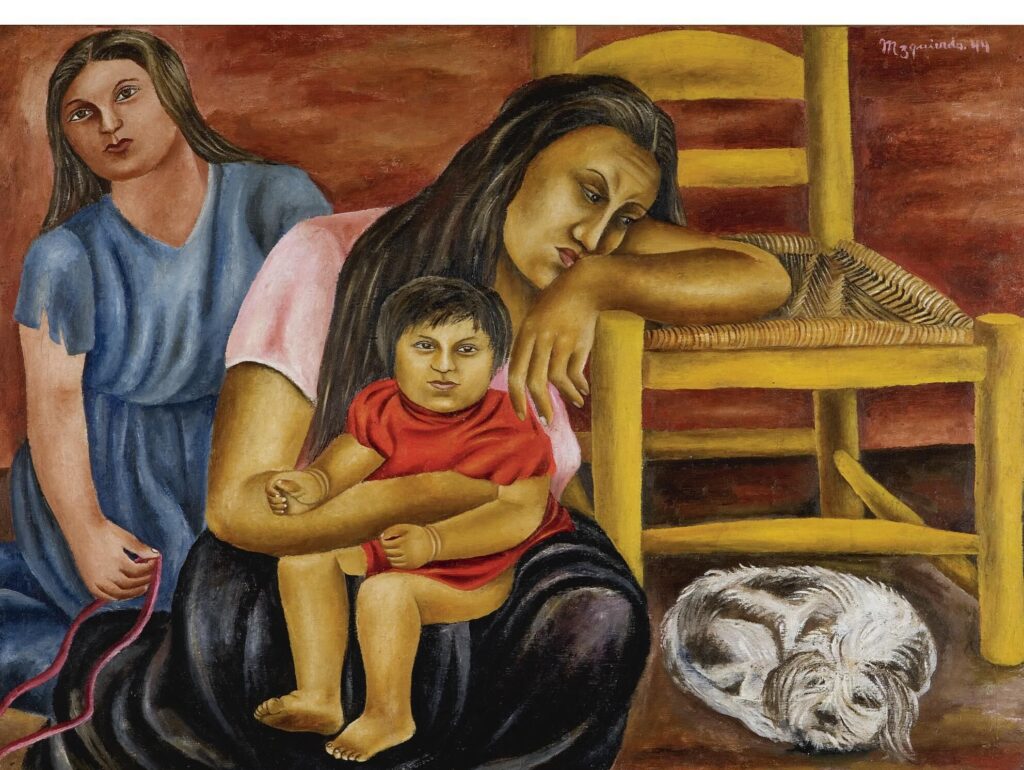
En esta obra, María Izquierdo representa a una mujer sentada en el suelo con la mirada perdida, reposando la cabeza sobre una silla; en sus brazos lleva a un niño mientras que atrás de ella está parada su hija que sujeta un hilo. Aunque este cuadro podría considerarse dentro de la corriente Indigenista predominante en el arte de esos años, la pintora parece hacer una crítica hacia la condición de las mujeres más pobres, cuya situación difícilmente mejoró tras la Revolución Mexicana.
Aurora Reyes (1908-1985)
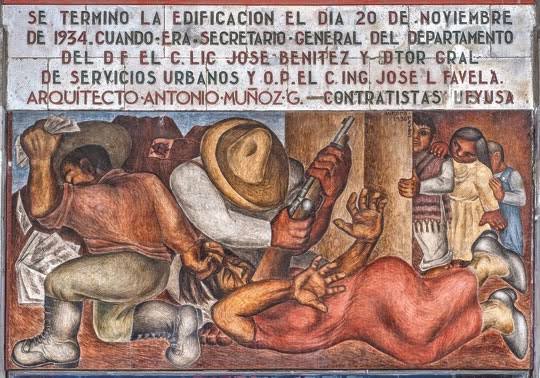
Este fue el primer mural pintado por una mujer mexicana en un edificio público, el Centro Escolar Revolución ubicado en el Centro de la Ciudad de México. En él, Aurora Reyes representa a una mujer brutalmente golpeada: un hombre la tortura con un rifle mientras que el segundo con una mano la jala del cabello y con la otra deshoja un libro; este segundo hombre con su cuerpo forma una esvástica. En él se muestra la brutal represión antes las luchas del magisterio siempre mayoritariamente femenino, especialmente en aquellos años de la lucha cristera que buscaba abolir la educación rural por considerarla socialista. Tras una columna, dos niños y una niña observan la escena. Aurora Reyes fue una de las pintoras con mayor participación política y fue parte activa del sindicato de trabajadoras y trabajadores de la educación.
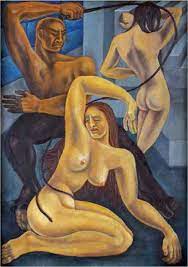
No puede ser más explícito. Un fornido hombre fustiga con un látigo a dos mujeres desnudas. Una está de espaldas y la otra de rodillas en el suelo, mientras su rostro muestra un gesto de dolor y disgusto con los ojos cerrados. Aurora Reyes, como parte de su actividad política, también formó parte del grupo feminista “Las pavorosas”, por lo que el tema de la violencia hacia las mujeres parece ser una de las preocupaciones de su obra.
Olga Costa (1913-1993)
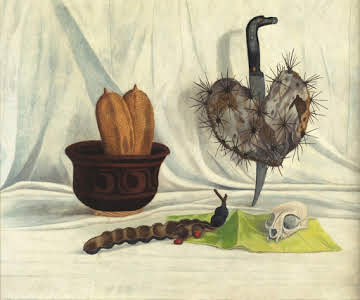
En esta obra, Olga Costa nos muestra una naturaleza muerta que hoy en día ha sido considerada parte de la influencia surrealista en México. En ésta podemos observar distintos elementos que se distinguen por estar secos e inertes: desde el cráneo de algún animal en reminiscencia de un vainitas, hasta partes de plantas endémicas, como la vaina de un capulín. Pero el objeto central de esta obra es un nopal seco en forma de corazón atravesado por un cuchillo. Por el mismo título de la obra, parece ser una crítica al amor, con una iconografía tradicional: el cuchillo como el dolor y el cráneo como fin del placer.
Exvotos

Nos vamos a referir ahora a los exvotos pintados de México, pero preciso decir que existen muy pocos en los cuales aparecen mujeres violentadas. Son anónimos, por lo tanto, no sabemos quién los pintó sino solamente la persona que los ofrece, en este caso, mujeres. Dos son supuestamente de la década de 1970 y otro de los 50. Pueden ser reales o inventados, no lo sabemos, pero son significativos en cuanto a mostrar la violencia hacia las mujeres.

Unos fuereños las empezaron a seguir con malas intenciones, asustadas “encomendamos nuestra honra” y en eso, unos peones del rancho aparecieron y los fuereños se espantaron y se fueron sin “atacar nuestra virtud”. 195…? 
La asaltaron, la violaron y da gracias que no salió embarazada. 1975
Sonia Félix Cherit (1961)

Artista visual, activista, feminista y directora de Casa de Engracia de Zacatecas realizó un mural, El vestido, 2020, para la exposición colectiva virtual Las ausentes. Las 43 participantes se expresaron contra la violencia hacia las mujeres. Dice la artista: “la obra tiene un contenido iconográfico que va del amor romántico, la pasión y el abandono, hasta llegar al feminicidio. La vieja existencia de ese mal que es la violencia hacia las mujeres reflejada desde la mitología y desde entonces quedando en la impunidad. La figura central del vestido -hecho de lodo y sangre- símbolo del abandono de nuestras muertas en muladares, desiertos y/o basureros. Donde muchas veces es la única prenda de identificación para sus seres queridos.” Esta exposición se presentó con motivo del décimo aniversario de Casa de Engracia.
Adriana Raggi (1970)
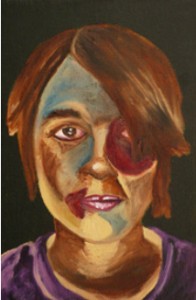
Adriana Raggi. Autorepresentación. S/F. 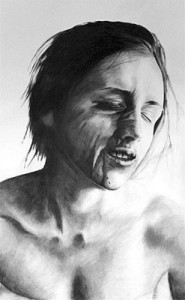
Adriana Raggi. Autorepresentación. S/F.
Un rostro, presumiblemente el de ella, todo golpeado. Ojo morado y demás signos de la violencia hacia ella. Lo mismo que en otro dibujo, en el que también aparece una mujer maltratada en su totalidad.
Colectivo Lapiztola (2006)

Lapiztola surgió en el año 2006 cuando se dio un fuerte conflicto entre el magisterio y el gobierno del estado de Oaxaca. Está compuesto por Rosario Martínez, Roberto Vega y Yankel Balderas, quienes se han dedicado al arte urbano con stencil y serigrafía. En Sembremos sueños, cosechemos esperanzas, Lapiztola buscó hacer un homenaje a Bety Cariño, defensora de los derechos humanos, las mujeres y los pueblos originarios, que fue asesinada en 2010 por un grupo paramilitar en el pueblo de San Juan Copala. Esta obra estuvo plasmada en un muro del centro de la ciudad de Oaxaca, cuyo gobierno pidió que se borrara en el año 2015.
Mar Negro (2019)
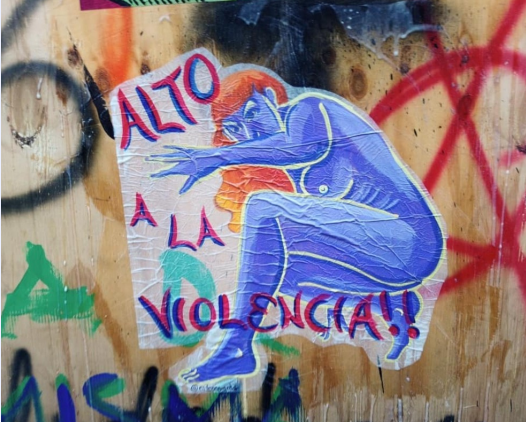
Mar Negro es una joven ilustradora y artista urbana originaria de la Ciudad de México. Es parte de PasteUp Morras, quienes se dedican, como lo dice su nombre, a crear arte urbano con paste up. Su obra trata de denunciar la violencia, el feminicidio y resignificar la disidencia sexual. En su obra frecuentemente están presentes cuerpos femeninos.
Colectiva PasteUpMorras (2020)
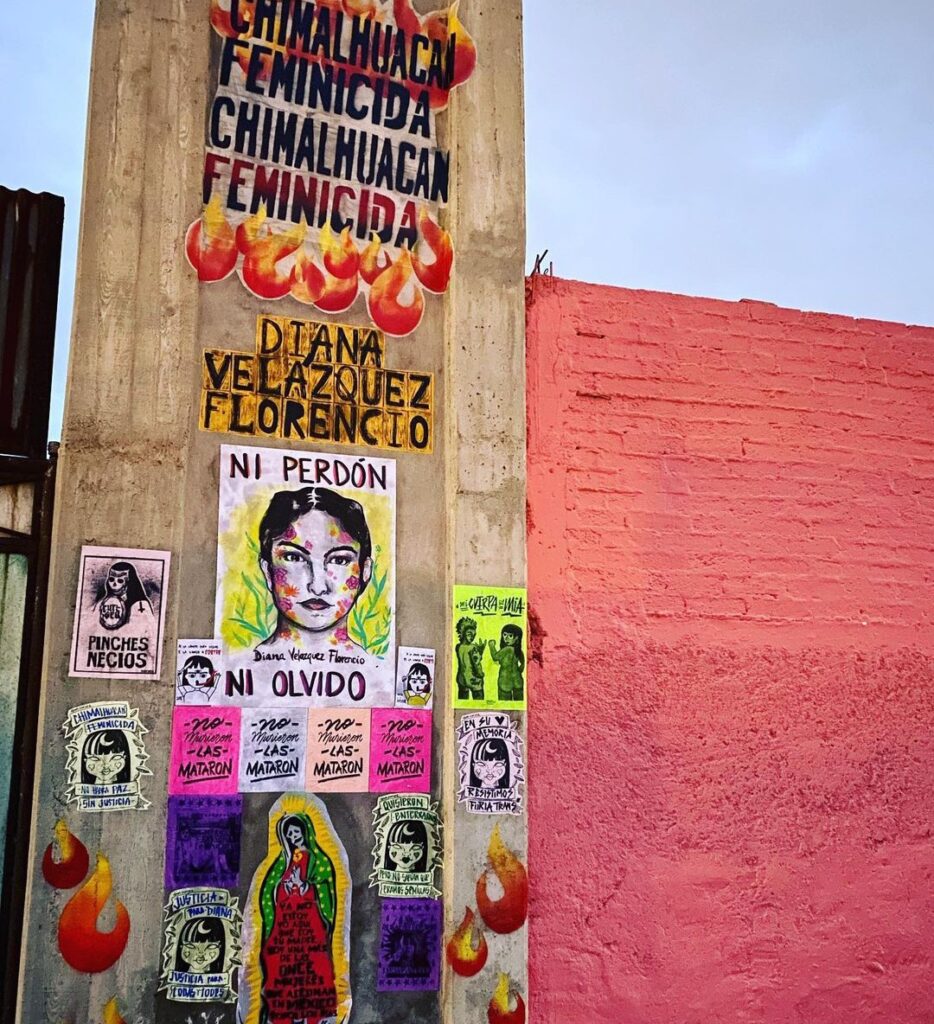
PasteUp Morras es una colectiva de mujeres dedicadas al arte urbano. Ellas se enfocan en denunciar con sus obras el acoso, la violencia y a defender la libertad de las mujeres. Su obra se encuentra tanto en la Ciudad de México como en el Estado de México, especialmente en zonas en donde se han dado desapariciones y feminicidios. Su obra busca apropiarse con el arte de un espacio normalmente hostil para ser mujer.
INSTALACIÓN Y PERFORMANCE
Elina Chauvet (1959)

Zapatos rojos, arte público, es una inequívoca instalación que denuncia el feminicidio en Ciudad Juárez, Chihuahua. Este trabajo se ha ido presentando en distintos lugares de México y en unos ocho países, quizá se acerca hoy al centenar de instalaciones. La propia artista afirmó que “Vivimos una pandemia de feminicidios desde hace 30 años en México”. Se recuperan los zapatos rojos, símbolo de la feminidad impuesta pero, además, los puros zapatos, inmóviles restos de las mujeres que ya no están.
María María Acha-Kutscher (1968)

Artista feminista transcultural y pluricultural. Bellas durmientes, performance, es un proyecto contra la violencia machista mediante la denuncia que involucra a muchas personas de la sociedad a partir de una convocatoria amplia.
Sonia Félix Cherit (1961)

Sonia Félix Cherit organizó en 2020 la exposición “Las ausentes”, en Casa Engracia, Zacatecas, en el marco de los 10 años de la Casa. En 2010 estuvo en el Encuentro Feminista Nacional, Zacatecas, pero se ha mostrado en varios otros lugares. “No más violencia contra las mujeres” es el grito de esta obra. Un enorme cuerpo de mujer rojo cuelga frente a un lienzo lleno de fotos de mujeres que dicen “No más…” Un montón de arena sembrada de partes corporales rojas se encuentra en el centro.

Abarca muchos temas, el acoso sexual, la trata, el tráfico de órganos y el feminicidio de niñas, todos referidos a las violencia que sufren las mujeres. Un hombre rico lleva una maleta, La maleta, en la que se halla una niña descuartizada.

En otro maletín lleva órganos, en una maleta más están todas las pruebas de las niñas secuestradas y asesinadas. Expone así, a lo largo del performance, la combinación explosiva de narco-gobiernos-ricos en el poder.
Natalia Eguiliz (1978)

Un elocuente comentario visual sobre la mutilación y la falta de libertad de las mujeres en las labores domésticas simbolizadas con el mandil rosa, por supuesto.
Katia Olalde

Una hermosa mujer negra, con cabello rosa, de perfil y labios carmín, quiere agarrar una mariposa multicolor, símbolo de la libertad alada.
FOTOGRAFÍA
Nacho López (1923-1986)
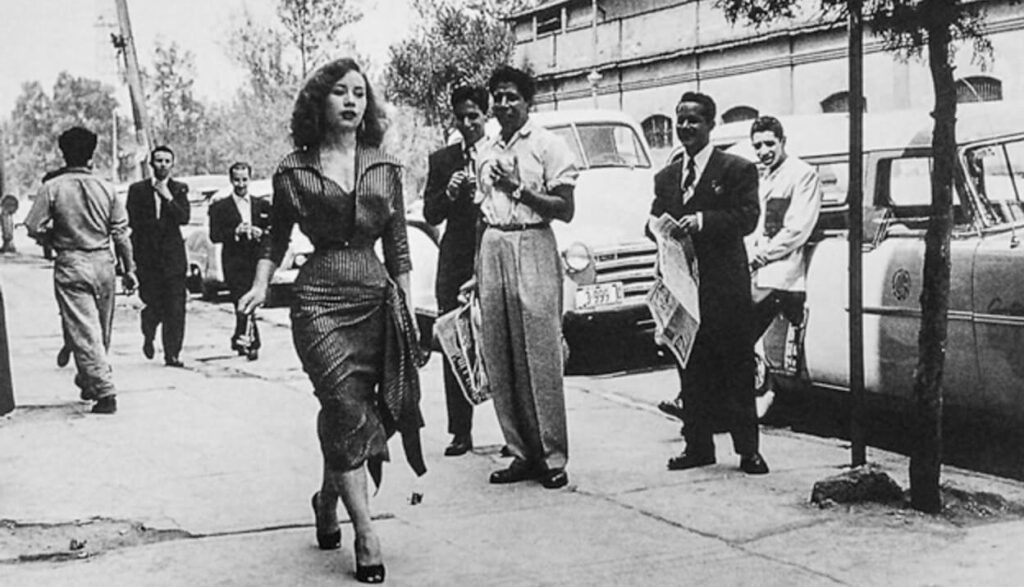
Un grupo de hombres lanza piropos y miradas a la modelo y actriz Maty Huitrón. Se trata de una foto dirigida por el fotógrafo, quien le dijo a su amiga Maty que caminara por ahí para provocar los piropos.
Lola Álvarez Bravo (1907-1993)
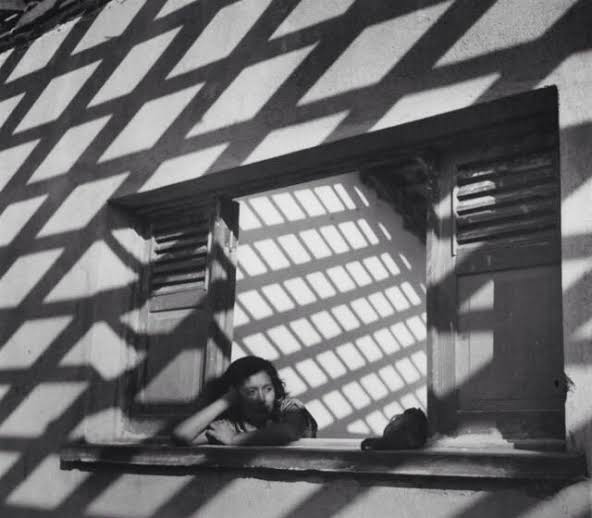
Una mujer mira de soslayo por una ventana abierta. La sombra de una reja cuadriculada se halla encima de toda la foto. Metáfora, tal vez, del encierro de esta mujer en su casa. Lola Álvarez Bravo en algunas de sus fotografías y fotocollages retrata a mujeres tanto en el ámbito doméstico como en su incursión en la educación y en el mercado laboral, siempre con una mirada crítica y, aparentemente, feminista.
Rotmi Enciso (1962)
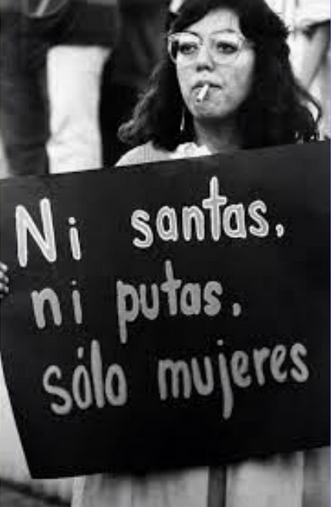
Esta fotografía es icónica en la obra de Rotmi Enciso. En ella se retrata a una mujer en la Marcha del 8 de marzo de hace 30 años.
Sonia Madrigal (1978)
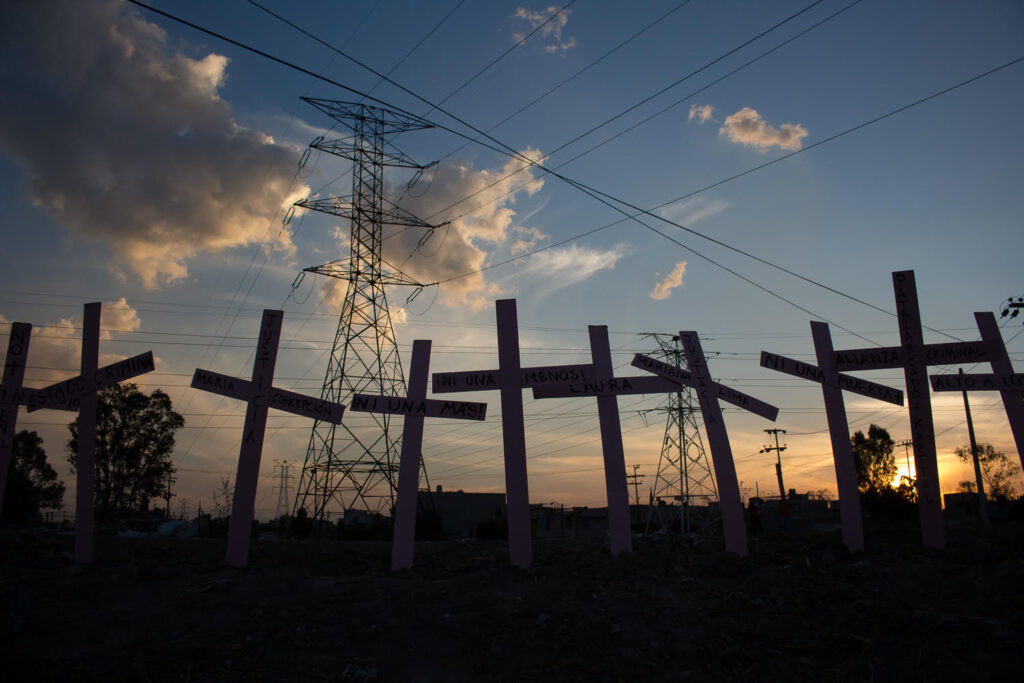
La muerte sale por el oriente es un trabajo que aborda el tema de la violencia feminicida en el estado de México y se sustenta en tres ejes: fotografía documental, intervención del territorio y mapeo digital colectivo. Este trabajo lo inició en 2014 y sigue en proceso.
Daniela Edburg (1975)

Entre la realidad y la ficción. 2017. 
Lo que queda del día. 2008. 
Lo que queda del día. 2008.
Entre la realidad y la ficción y Lo que queda del día son proyectos eminentemente claros sobre los feminicidios en México; en las tres imágenes las mujeres yacen en el suelo del campo. En la primera, la ficción seguramente está representada por el anuncio del toro mientras que la cruda realidad es la mujer que yace. Las otras dos hacen referencia a las mujeres asesinadas y sembradas cual despojos en cualquier parte.
Mónica González (1976)

En Juchitán, Oaxaca, por tradición, la hija menor tiene que cuidar a sus padres en la vejez. Estrella representa para su madre seguridad económica y compañía. Su padre no acepta que decidiera ser muxe. Ser muxe es para la población zapoteca del Valle Central en Juchitán, un orgullo. Sin embargo, Estrella considera que existe cierto rechazo. En los últimos años se ha registrado una serie de asesinatos y agresiones a miembros de la comunidad homosexual. Mónica González dice: “Ser fotoperiodista en temas vinculados con la violencia no es nada fácil si se es mujer”. Tiene un proyecto (en video) que se llama “Geografía del dolor.”
Romina Solís (1985)

Esta fotografía es un símil de El Piropo, de Nacho López. Sin embargo, esta no está dirigida hasta donde sabemos. Es la respuesta más que frecuente de los hombres acosando a las mujeres jóvenes y bellas. ¡Podemos incluso escuchar los silbidos!
CINE DOCUMENTAL
Lucía Gajá (1974)
Cinco mujeres de cinco países cuentan sus historias de maltrato doméstico: Finlandia, España, México, India y Estados Unidos. Es importante ver las coincidencias entre lugares tan diferentes y con tan distinto desarrollo económico. Culturas, realidades políticas y sociales muy diversas confluyen en una misma problemática.
Tatiana Huezo (1972)
Dos testimonios relacionados con el crimen organizado, la cárcel en México… y las siempre presentes desaparecidas.
Carolina Corral (1984)
Este corto de animación es un relato visual sobre mujeres privadas de su libertad, que sucumben a la más que frecuente cárcel del matrimonio.
Te puede interesar: Aumenta la venta de armas y también la violencia doméstica: expertos

